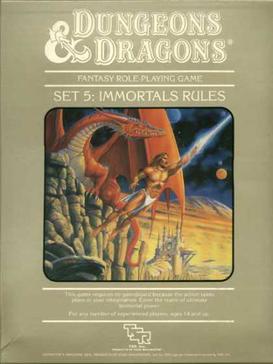I started to feel that I didn’t know roleplaying games well enough so I came up with the plan to read a roleplaying game corebook for every year they have been published. Selection criteria is whatever I find interesting.

I started roleplaying around the fourth grade, probably around 1990. A friend had the D&D red box and I played a wizard who was later eaten by a purple worm. Soon I moved to running games myself. I got a copy of the red box from a toy store and soon read its sequels as well.
At that time, there were two parallel D&D games. AD&D, or Advanced Dungeons & Dragons, was published in hardcover books with many supplements. It had an entry-level sibling simply called Dungeons & Dragons, ostensibly easier and more streamlined.
D&D came in a series of boxed rule sets of increasing complexity. As your characters gained levels you also had to move to the next box to find the appropriate rules. Of the five box series, the first four were published in Finnish: Perussäännöt, Ekspert-säännöt, Mestarisäännöt and Sankarisäännöt.
The final box, Immortals Rules, was never translated and I never read it. Until now!
The first four boxes detail the journey of a character from level 1 to 36, the game’s maximum. In Immortals Rules, the character has ascended to Immortality, essentially becoming a demigod. The box details the rules needed for Immortal level play.
It’s pretty strange stuff! Let me sketch out the cosmology of the world inhabited by the Immortals:
First, there’s the Prime Plane where almost all Immortals come from. It consists of planets, solar systems and so on. The world inhabited by the player characters (later to be known as Mystara) is also our Earth, just a very long time in the past. It’s map is that of Pangea.
The planet is also a singular being called Urt, sort of like Ego the Living Planet in Marvel comics.
Around the Prime Plane there are the Ethereal and Astral Planes and the Inner Planes of Fire, Water, Earth and Air. There are also an infinite multitude of Outer Planes of strange shapes and sizes.
This is familiar so far if you know your D&D cosmology.
However, there’s also the matter of Dimensions. Mortal characters exist in three-dimensional space. Immortal characters are four-dimensional. The fourth Dimension covers teleportation (not Time, as Time is a Sphere). The fifth Dimension is that of Nightmares.
The characters are barred from higher Dimensions because of the Dimensional Vortex. Some creatures exist in non-standard set of dimensions, such as the third, the fourth and the fifth.
There are handy tables you can use to randomly determine how many Dimensions a given plane has. Reading this portion of the booklets often feels like a Theosophy-flavored take on the novel Flatland.
Immortals Rules make a definitive statement on two important questions:
- You can win in D&D.
- You can play D&D to the end.
In actual play, these two are the same. You do it by playing a character from level one to level 36, ascending to Immortal status, rising through the hierarchy to become a maximum level Immortal (a Hierarch), voluntarily becoming a mortal again, working your way from one to level 36, ascending to Immortality a second time, becoming a Hierarch and finally transcending to a type of super-god known as an Old One.
At this point, according to the rules, you have finished D&D and won the game.
I’m not absolutely sure what Immortal-level play is supposed to look like in practice but the box is charming in its eccentricity and conceptual approach. It feels like a precursor to Amber and Nobilis, two later games where the characters had immense power.
One thought on “A Game Per Year: D&D Immortals Rules (bonus 1986)”
Comments are closed.